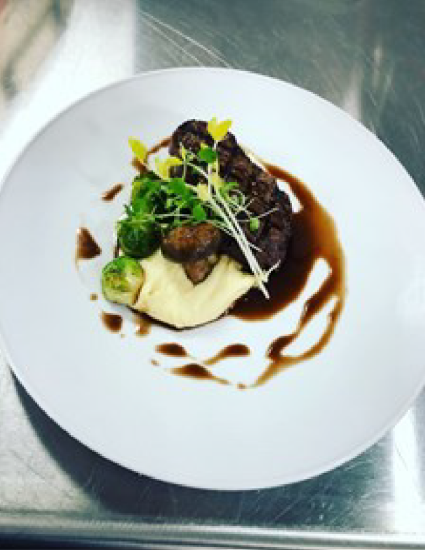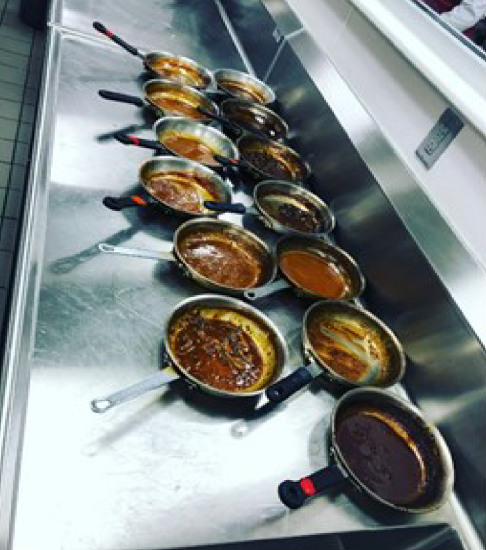1.4: Demi-Based Sauces
- Page ID
- 21153
\( \newcommand{\vecs}[1]{\overset { \scriptstyle \rightharpoonup} {\mathbf{#1}} } \)
\( \newcommand{\vecd}[1]{\overset{-\!-\!\rightharpoonup}{\vphantom{a}\smash {#1}}} \)
\( \newcommand{\id}{\mathrm{id}}\) \( \newcommand{\Span}{\mathrm{span}}\)
( \newcommand{\kernel}{\mathrm{null}\,}\) \( \newcommand{\range}{\mathrm{range}\,}\)
\( \newcommand{\RealPart}{\mathrm{Re}}\) \( \newcommand{\ImaginaryPart}{\mathrm{Im}}\)
\( \newcommand{\Argument}{\mathrm{Arg}}\) \( \newcommand{\norm}[1]{\| #1 \|}\)
\( \newcommand{\inner}[2]{\langle #1, #2 \rangle}\)
\( \newcommand{\Span}{\mathrm{span}}\)
\( \newcommand{\id}{\mathrm{id}}\)
\( \newcommand{\Span}{\mathrm{span}}\)
\( \newcommand{\kernel}{\mathrm{null}\,}\)
\( \newcommand{\range}{\mathrm{range}\,}\)
\( \newcommand{\RealPart}{\mathrm{Re}}\)
\( \newcommand{\ImaginaryPart}{\mathrm{Im}}\)
\( \newcommand{\Argument}{\mathrm{Arg}}\)
\( \newcommand{\norm}[1]{\| #1 \|}\)
\( \newcommand{\inner}[2]{\langle #1, #2 \rangle}\)
\( \newcommand{\Span}{\mathrm{span}}\) \( \newcommand{\AA}{\unicode[.8,0]{x212B}}\)
\( \newcommand{\vectorA}[1]{\vec{#1}} % arrow\)
\( \newcommand{\vectorAt}[1]{\vec{\text{#1}}} % arrow\)
\( \newcommand{\vectorB}[1]{\overset { \scriptstyle \rightharpoonup} {\mathbf{#1}} } \)
\( \newcommand{\vectorC}[1]{\textbf{#1}} \)
\( \newcommand{\vectorD}[1]{\overrightarrow{#1}} \)
\( \newcommand{\vectorDt}[1]{\overrightarrow{\text{#1}}} \)
\( \newcommand{\vectE}[1]{\overset{-\!-\!\rightharpoonup}{\vphantom{a}\smash{\mathbf {#1}}}} \)
\( \newcommand{\vecs}[1]{\overset { \scriptstyle \rightharpoonup} {\mathbf{#1}} } \)
\( \newcommand{\vecd}[1]{\overset{-\!-\!\rightharpoonup}{\vphantom{a}\smash {#1}}} \)
\(\newcommand{\avec}{\mathbf a}\) \(\newcommand{\bvec}{\mathbf b}\) \(\newcommand{\cvec}{\mathbf c}\) \(\newcommand{\dvec}{\mathbf d}\) \(\newcommand{\dtil}{\widetilde{\mathbf d}}\) \(\newcommand{\evec}{\mathbf e}\) \(\newcommand{\fvec}{\mathbf f}\) \(\newcommand{\nvec}{\mathbf n}\) \(\newcommand{\pvec}{\mathbf p}\) \(\newcommand{\qvec}{\mathbf q}\) \(\newcommand{\svec}{\mathbf s}\) \(\newcommand{\tvec}{\mathbf t}\) \(\newcommand{\uvec}{\mathbf u}\) \(\newcommand{\vvec}{\mathbf v}\) \(\newcommand{\wvec}{\mathbf w}\) \(\newcommand{\xvec}{\mathbf x}\) \(\newcommand{\yvec}{\mathbf y}\) \(\newcommand{\zvec}{\mathbf z}\) \(\newcommand{\rvec}{\mathbf r}\) \(\newcommand{\mvec}{\mathbf m}\) \(\newcommand{\zerovec}{\mathbf 0}\) \(\newcommand{\onevec}{\mathbf 1}\) \(\newcommand{\real}{\mathbb R}\) \(\newcommand{\twovec}[2]{\left[\begin{array}{r}#1 \\ #2 \end{array}\right]}\) \(\newcommand{\ctwovec}[2]{\left[\begin{array}{c}#1 \\ #2 \end{array}\right]}\) \(\newcommand{\threevec}[3]{\left[\begin{array}{r}#1 \\ #2 \\ #3 \end{array}\right]}\) \(\newcommand{\cthreevec}[3]{\left[\begin{array}{c}#1 \\ #2 \\ #3 \end{array}\right]}\) \(\newcommand{\fourvec}[4]{\left[\begin{array}{r}#1 \\ #2 \\ #3 \\ #4 \end{array}\right]}\) \(\newcommand{\cfourvec}[4]{\left[\begin{array}{c}#1 \\ #2 \\ #3 \\ #4 \end{array}\right]}\) \(\newcommand{\fivevec}[5]{\left[\begin{array}{r}#1 \\ #2 \\ #3 \\ #4 \\ #5 \\ \end{array}\right]}\) \(\newcommand{\cfivevec}[5]{\left[\begin{array}{c}#1 \\ #2 \\ #3 \\ #4 \\ #5 \\ \end{array}\right]}\) \(\newcommand{\mattwo}[4]{\left[\begin{array}{rr}#1 \amp #2 \\ #3 \amp #4 \\ \end{array}\right]}\) \(\newcommand{\laspan}[1]{\text{Span}\{#1\}}\) \(\newcommand{\bcal}{\cal B}\) \(\newcommand{\ccal}{\cal C}\) \(\newcommand{\scal}{\cal S}\) \(\newcommand{\wcal}{\cal W}\) \(\newcommand{\ecal}{\cal E}\) \(\newcommand{\coords}[2]{\left\{#1\right\}_{#2}}\) \(\newcommand{\gray}[1]{\color{gray}{#1}}\) \(\newcommand{\lgray}[1]{\color{lightgray}{#1}}\) \(\newcommand{\rank}{\operatorname{rank}}\) \(\newcommand{\row}{\text{Row}}\) \(\newcommand{\col}{\text{Col}}\) \(\renewcommand{\row}{\text{Row}}\) \(\newcommand{\nul}{\text{Nul}}\) \(\newcommand{\var}{\text{Var}}\) \(\newcommand{\corr}{\text{corr}}\) \(\newcommand{\len}[1]{\left|#1\right|}\) \(\newcommand{\bbar}{\overline{\bvec}}\) \(\newcommand{\bhat}{\widehat{\bvec}}\) \(\newcommand{\bperp}{\bvec^\perp}\) \(\newcommand{\xhat}{\widehat{\xvec}}\) \(\newcommand{\vhat}{\widehat{\vvec}}\) \(\newcommand{\uhat}{\widehat{\uvec}}\) \(\newcommand{\what}{\widehat{\wvec}}\) \(\newcommand{\Sighat}{\widehat{\Sigma}}\) \(\newcommand{\lt}{<}\) \(\newcommand{\gt}{>}\) \(\newcommand{\amp}{&}\) \(\definecolor{fillinmathshade}{gray}{0.9}\)A sauce is a thickened liquid used to flavor and enhance other foods. A good sauce adds flavor, moisture, richness and visual appeal. A sauce should complement food; it should never disguise it. A sauce can be hot or cold, sweet or savory, smooth or chunky.
Although the thought of preparing stocks and sauces may be intimidating, the procedures are really quite simple. Follow the basic procedures outlined in this chapter, use highquality ingredients and, with practice and experience, you will soon master fine stocks and sauces.
The Espagnole Family
Espagnole is the French word for "Spanish", but the sauce's origin story is argued by French cooks. According to Louis Diat, the creator of vichyssoise and the author of the classic Gourmet's Basic French Cookbook: "There is a story that explains why the most important basic brown sauce in French cuisine is called sauce espagnole, or Spanish sauce. According to the story, the Spanish cooks of Louis XIII's bride, Anne, helped to prepare their wedding feast, and insisted upon improving the rich brown sauce of France with Spanish tomatoes. This new sauce was an instant success, and was gratefully named in honor of its creators."
Espagnole sauce is a basic ‘brown sauce’, has a strong taste, and is sparingly used directly on food. As a mother sauce, it serves as the starting point for many derivatives. The mother sauce of the espagnole or brown sauce family is full-bodied and rich. It is made from a brown stock to which brown roux, mirepoix and tomato puree have been added. Most often, this sauce is used to produce demi-glace. Brown stock is also used to make jus lie. Demi-glace and jus lie are intermediary sauces used to create the small sauces of the espagnole family.
Yield: 1 gal. (4 lt)
- Mirepoix, medium dice 2 lb. (1 kg)
- Clarified butter 8 fl. oz. (250 ml)
- Flour 8 oz. (250 g)
- Brown stock 5 qt. (5 lt)
- Tomato puree 8 oz. (250 g)
Sachet
- Bay leaf 1 (1)
- Dried thyme ½ tsp. (2 ml)
- Peppercorns, crushed ¼ tsp. (1 ml)
- Parsley stems 8 (8)
- Salt and pepper TT (TT)
- Sauté the mirepoix in butter until well caramelized.
- Add the flour and cook to make a brown roux.
- Add the stock and tomato puree. Stir to break up any lumps of roux. Bring to a boil; reduce to a simmer.
- Add the sachet.
- Simmer for approximately 1½ hours, allowing the sauce to reduce. Skim the surface as needed to remove impurities.
- Strain the sauce through a china cap lined with several layers of cheesecloth. Adjust seasonings and cool in a water bath or hold for service.
Demi-Glace
Brown stock is used to make the espagnole or brown sauce described earlier. Espagnole sauce can then be made into demi-glace, which in turn is used to make the small sauces of the espagnole family. Demi-glace is half brown sauce, half brown stock, reduced by half. It is usually finished with a small amount of Madeira or sherry wine. Because demi-glace creates a richer, more flavorful base, it produces finer small sauces than those made directly from a brown sauce.
A properly made demi-glace is rich, smooth and lump-free. Its prominent roasted flavor comes from the bones used for the brown stock. There should be no taste of roux. The caramelized bones and mirepoix as well as the tomato product contribute to its glossy dark brown, almost chocolate, color. It should be thick enough to cling to food without being pasty or heavy.
Yield: l qt. (1 It)
- Brown stock 1 qt. (1 lt)
- Brown sauce 1 qt. (1 lt)
- Combine the stock and sauce in a saucepan over medium heat.
- Simmer until the mixture is reduced by half (a yield of l quart or 1 liter).
- Strain and cool in a water bath.
Jus Lie
Jus lie, also known as fond lie, is used like a demi-glace, especially to produce small sauces. Jus lie is lighter and easier to make than a demi-glace, however. It is made in one of two ways:
- A rich brown stock is thickened with cornstarch or arrowroot and seasoned.
- A rich brown stock is simmered and reduced so that it thickens naturally because of the concentrated amounts of gelatin and other proteins.
The starch-thickened method is a quick alternative to the long-simmering demiglace. However, because it is simply a brown stock thickened with cornstarch or arrowroot, it will be only as good as the stock with which it was begun. Sauces made from reduced stock usually have a better flavor but can be expensive to produce because of high food costs and lengthy reduction time.
A properly made jus lie is very rich and smooth. It shares many flavor characteristics with demi-glace. Its color should be dark brown and glossy from the concentrated gelatin content. Its consistency is somewhat lighter than demi-glace, but it should still cling lightly to foods.
Gravy
A gravy is a jus (the natural juices from a roast) that has been thickened with flour. Depending on the amount of cooking liquid remaining in the roasting pan, gravies can be prepared using one of two similar techniques. If a small amount of jus remains in the pan, it should be boiled down on top of the stove until it caramelizes; all but a tablespoon or two of fat should be removed and discarded. The flour is then added and cooked for 2 or 3 minutes in the roasting pan on top of the stove; the mixture is then moistened with stock, water, or other liquids.
If a large amount of roasting jus remains in the pan, it should be transferred to a saucepan or glass container and the fat skimmed off with a ladle. A roux is then prepared in the roasting pan with a little of the fat or some fresh butter. The jus is then returned to the roasting pan and whisked until smooth and thickened. Because flour used as a last-minute thickener for gravies has little time to cook, an alternative is to use a previously thickened veloute- or espagnole-style flour-thickened sauce instead of plain stock to deglaze the pan; the roux is then omitted.
Small Brown Sauces
Demi-glace and jus lie are used to produce many small sauces. The quantities given are for 1 quart (1 liter) demi-glace or jus lie. The final step for each recipe is to season to taste with salt and pepper.
BORDELAISE - Combine 16 fluid ounces (500 milliliters) dry red wine, 2-ounces (60 grams) chopped shallots, 1 bay leaf, 1 sprig thyme and 1 pinch black pepper in a saucepan. Reduce by three-fourths, then add demi-glace and simmer for 15 minutes. Strain through a fine chino is. Finish with 2-ounces (60 grams) whole butter and garnish with sliced, poached beef marrow.
CHASSEUR (HUNTER'S SAUCE) - Sauté 4-ounces (120 grams) sliced mushrooms and 1/2 ounce (15 grams) diced shallots in whole butter. Adel 8 fluid ounces (250 milliliters) white wine and reduce by three -fourths. Then acid demiglace and 6 ounces (170 grams) diced tomatoes; simmer for 5 minutes. Do not strain. Garnish with chopped parsley.
CHATEAUBRIAND - Combine 16 fluid ounces (500 milliliters) dry white wine and 2-ounces (60 grams) diced shallot s. Reduce the mixture by two-thirds. Add demi-glace and reduce by half. Season to taste with lemon juice and cayenne pepper. Do not strain. Swirl in 4-ounces (120 grams) whole butter to finish and garnish with chopped fresh tarragon.
CHEVREUIL - Prepare a poivrade sauce but add 6 ounces (170 grams) bacon or game trimmings to the mirepoix. Finish with 4 fluid ounces (120 milliliters) red wine and a dash of cayenne pepper.
MADEIRA OR PORT - Bring demi-glace to a boil and reduce slightly. Then add 4 fluid ounces (120 milliliters) Madeira wine or ruby port.
MARCHAND DE VIN - Reduce 8 fluid ounces (250 milliliters) dry reel wine and 2 ounces (60 grams) diced shallots by two-thirds. Then add demi-glace, simmer and strain.
MUSHROOM - Blanch 8-ounces (250 grams) mushroom caps in 8 fluid ounces (250 milliliters) boiling water seasoned with salt and lemon juice. Drain the mushrooms, saving the liquid. Reduce this liquid to 2- tablespoons (30 milliliters) and add it to the demi -glace. Just before service stir in 2-ounces (60 grams) whole butter and the mushroom caps.
PERIGUEUX - Add finely diced truffles to Madeira sauce. Perigourdine sauce is the same, except that the truffles are cut into relatively thick slices.
PIQUANT - Combine 1-ounce (30 grams) shallots, 4 fluid ounces (120 milliliters) white wine and 4 fluid ounces (120 milliliters) white wine vinegar. Reduce the mixture by two-thirds. Then add demi-glace and simmer for 10 minutes. Add 2-ounces (60 grams) diced cornichons, 1-tablespoon (15 milliliters) fresh tarragon, 1-tablespoon (15 milliliters) fresh parsley and 1-tablespoon (15 milliliters) fresh chervil. Do not strain.
POIVRADE - Sweat 12-ounces (340 grams) mirepoix in 2-tablespoons (30 milliliters) oil. Add 1 bay leaf, 1 sprig thyme and 4 parsley stems. Then add 16 fluid ounces (500 milliliters) vinegar and 4 fluid ounces (120 milliliters) white wine. Reduce by half, add demi-glace and simmer for 40 minutes. Then add 20 crushed peppercorns and simmer for 5 more minutes. Strain through a fine chinois and finish with up to 2-ounces (60 grams) whole butter.
ROBERT - Sauté 8-ounces (250 grams) chopped onion in 1-ounce (30 grams) whole butter. Add 8 fluid ounces (250 milliliters) dry white wine and reduce by two -thirds. Add demi-glace and simmer for 10 minutes. Strain and then add 2-teaspoons (10 milliliters) prepared Dijon mustard and 1-tablespoon (15 milliliters) granulated sugar. If the finished Robert sauce is garnished with sliced sour pickles, preferably cornichons, it is known as Charcutiere.

Demi sauce plate up example. Photo Credit Amelie Zeringue

Different demi sauces preapred in class. Photo Credit: Amelie Zeringue


